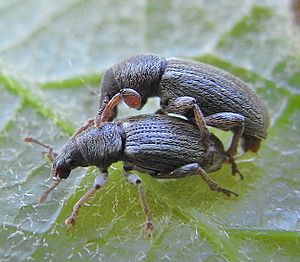Polydrusus marginatus
| Polydrusus marginatus | ||||||||||||
|---|---|---|---|---|---|---|---|---|---|---|---|---|

Polydrusus marginatus in copulation |
||||||||||||
| Systematics | ||||||||||||
|
||||||||||||
| Scientific name | ||||||||||||
| Polydrusus marginatus | ||||||||||||
| ( Stephens , 1831) |
The glossy weevil Polydrusus marginatus is a beetle from the family of weevils and the subfamily Entiminae . The species belongs to the subgenus Metallites . Although the species is one of the glossy weevils, the scales are not shiny metallic, as in the namesake species.
The species is not included in the Red List of Endangered Species in Germany or in country lists .
Notes on the name
The species was first described by Stephens in 1831 under the name Polydrusus marginatus . The short Latin characterization contains the phrase: thoracis elytrorumque lateribus albidis ( Latin: "white on the sides of the chest and elytra "). This explains the species name marginatus (Latin for "bordered"), even if this border often does not appear.
The genus name is first mentioned by Germar in 1817, when he announced a revision of the weevils and indicated the planned division into 52 genera. Among the new genera he names Polydrusus . Schenkling notes that the correct spelling is Polydrosus and the name of Altgr. πολύς polýs, "much" and δρόσος drósos, "dew" is derived. The name is probably inspired by the abundant scaling of the species. Both spellings are common in historical documents. The sub-genus Metallites (from old Gr. Μέταλλον métallon, "metal") is partially considered as a genus.
The genus Polydrusus is very species-rich, in Europe it is represented with 18 subgenus, the number of species of the subgenus Metallites varies greatly according to different sources.
Characteristics of the beetle
The body reaches a length of four to five millimeters. It has the shape typical of the genera Polydrusus and Phyllobius : it gradually widens from head to pronotum and from pronotum to the elytra , then runs roughly parallel to the rear and only narrows in the last quarter of the elytra. The top is covered with gray-brown hair-like scales that lie in different directions depending on the part of the body.
The mouthparts sit on an extension of the head, the trunk. The trunk is thick and relatively short and angular. It has no delimited smooth surface at the front. The furrow for inserting the first antennae (antennae) is on the trunk side. The antennae furrow is sharply defined and kinks down in front of the eyes. The head without a trunk is slender, the trunk roughly square when viewed from above. The kneeled antennae consist of a clubbed shaft and a seven-limbed, slender flagellum, which is followed by the four-limbed spindle-shaped club. The shaft clearly protrudes - placed backwards - the eyes. The first link of the antennae is slightly longer than the second, the following almost spherical. The round eyes are evenly and clearly arched.
The pronotum is roughly dotted . On the side, the scales of the pronotum are predominantly upwards, on top of the pronotum they fall forward on the front half, behind it backwards.
The elytra are only slightly wider than the pronotum and evenly arched. The shoulders protrude only a little. Clearly developed rows of large, elongated and dense points run parallel to the seam . The scales on the gaps are to the rear. The label is wider than it is long and has dense lighter scales behind. The hind wings are fully developed, the beetle is capable of flight.
The legs are short. The thighs have only a very weak tooth on the underside behind the middle. The tarsi are all pseudotetramer, so they appear to be four-part. The claws are fused at the base. The rear rails end at an angle, the cut surface is limited by a ring of short bristles, which is not closed at the top.
biology
The mildly heat-loving species makes little demands on the environment and is found in very different locations. It lives polyphagous on various trees and shrubs, including conifers . It prefers dry, open mixed forests on sunny slopes. In orchards and vineyards, it can be harmful through leaf damage. The insect gnaws at the leaf margins and perforates the leaves.
distribution
The species occurs in large parts of Europe, especially in all of Western and Central Europe. However, it is absent in the northeast ( Kaliningrad , Lithuania , Belarus, Ukraine and Moldova ) and southeast ( Greece , Albania , Macedonia and Serbia-Montenegro ). In Scandinavia it is only reported from Norway .
literature
- Heinz joy , Karl Wilhelm Harde , Gustav Adolf Lohse (ed.): The beetles of Central Europe . tape 10 : Bruchidae – Curculionidae 1 . Goecke & Evers , Krefeld 1981, ISBN 3-87263-029-6 .
- Gustav Jäger (Ed.): CG Calwer’s Käferbuch . K. Thienemanns, Stuttgart 1876, 3rd edition
- Edm.Reitter: Fauna Germanica, the beetles of the German Empire V. Volume, KG Lutz 'Verlag, Stuttgart 1916
- Klaus Koch : The Beetles of Central Europe . Ed .: Heinz Freude . tape 3 : ecology . Goecke & Evers, Krefeld 1992, ISBN 3-87263-042-3 . P. 222
Individual evidence
- ↑ a b Polydrusus (Metallites) marginatus Stephens, 1831 . Fauna Europaea. Retrieved July 20, 2017.
- ↑ Red lists at BioNetworkX
- ↑ James Francis Stephans: Illustrations of British Entomology . Vol. IV London 1831 Description p. 142
- ↑ Sigmund Schenkling: Explanation of the scientific beetle names (species)
- ↑ Hsg: Germar, Zinken called Sommer Magazin der Entomologie Halle, 2nd volume 1817 Polydrusus al new genus p. 341 .
- ↑ a b Sigmund Schenkling: Explanation of the scientific beetle names (genus)
- ↑ Polydrusus in Fauna Europaea. Retrieved March 16, 2013
- ↑ Metallites (subgenus) in Fauna Europaea. Retrieved March 16, 2013
- ↑ of the subgenus Metal Lites in BioLib
- ↑ Polish koleopterologische site